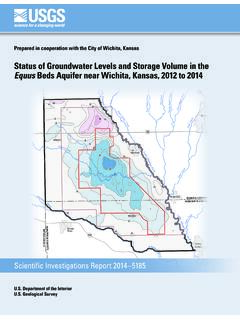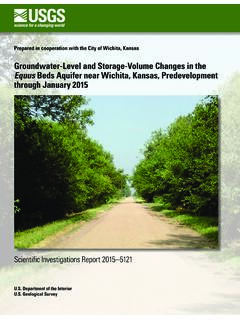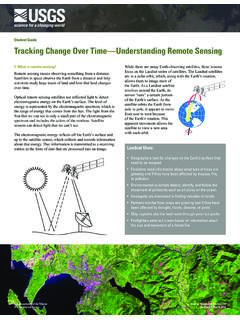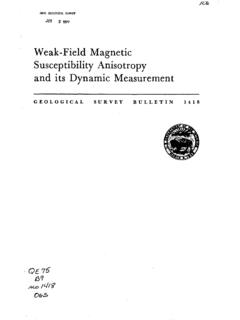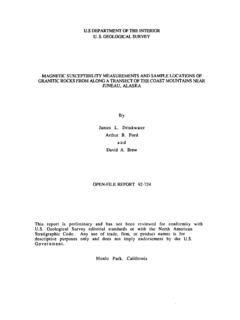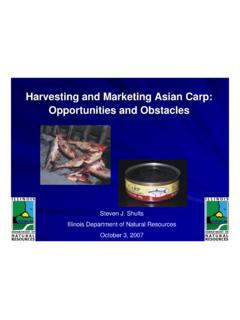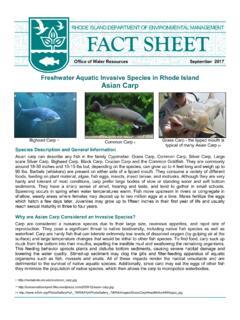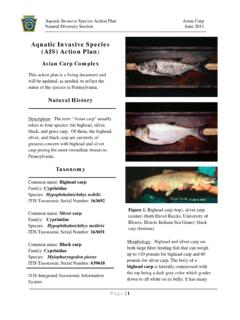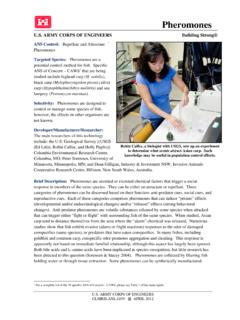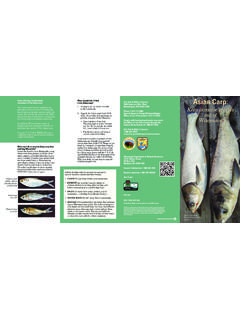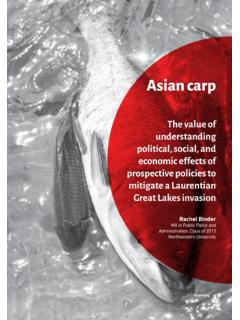Transcription of Facts About Invasive Bighead and Silver Carps
1 Department of the Geological SurveyFact Sheet 2010 3033 May 2010 Facts About Invasive Bighead and Silver CarpsBackground and Problem Bighead and Silver carp, together the bigheaded Carps , are native to China. In North America, the term asian Carps is used to refer to the bigheaded Carps together with the also- Invasive grass carp and black carp, or sometimes to the bigheaded Carps alone. Bigheaded Carps were imported in the 1970s for aqua-culture and use in sewage treatment. They escaped from captivity, and by the late 1990s had become extremely abundant in parts of the Mississippi River drainage.
2 In the United States, they are an undesirable pest species, and there is evidence of competition with native fishes. Bigheaded Carps can approach 100 pounds, but such sizes are rare. Silver carp commonly weigh up to 20 pounds, and Bighead carp commonly weigh up to 40 pounds (fig. 1). Bigheaded Carps eat plank-ton and have been shown to have dramatic effects on the amount and kinds of plank-ton. Most native fishes eat animal plankton during part of their life cycle, and some rely directly on plankton throughout their life.
3 Bigheaded carp populations have increased exponentially in the Mississippi River Basin and pose a threat to native species because of their efficient plank-ton feeding ability and high fecundity. Their range in the United States now extends from Louisiana to Minnesota on the Mississippi River, to South Dakota on the Missouri River, to Ohio on the Ohio River, and throughout the Illinois River Basin. Silver carp jump from the water when frightened.
4 Because moving boats frighten the carp (fig. 2), Silver carp often jump into boats, sometimes injuring boaters or damaging equipment. Sometimes schools of Silver carp will jump simultaneously. Unlike the Silver carp, the Bighead carp does not jump in response to boat traffic. Bigheaded Carps are poised to invade the Great Lakes, and there is great concern About their effects on the Great Lakes ecology and economy. It remains unknown if they will achieve large populations or have substantial undesirable effects there, but because of the value of the Great Lakes fisheries, the carp are thought to pose a substantial risk.
5 In 2007, a stakeholder group led by the Fish and Wildlife Service completed the Management and Control Plan for Bighead , Black, Grass, and Silver Carps in the United States. The Plan outlines strategies for controlling these species, including basic life history research. In 2010, in response to the threat of asian carp invasion of the Great Lakes, an asian Carp Workgroup was formed and a Frame-work for preventing establishment of Bighead and Silver carp in the Great Lakes was assembled.
6 USGS research sup-ports specific goals of the Plan and the of Geological Survey Research on Bighead and Silver CarpBehavior Adult bigheaded Carps in the Missouri River and its tribu-taries select habitats with low water velocity and depths more than 2 meters. Bigheaded Carps are active in cold water; activity increased and feeding began when the water temperature rose above 2 4 C (36 39 F).Figure 1. A Geological Survey biologist holds a Bighead carp caught in the Missouri 2. Silver carp jump behind a Geological Survey research boat.
7 Note the protective nets on the Geological Survey (USGS) scientists at the Columbia Environmental Research Center (CERC), Colum-bia, Missouri, carry out basic and applied research on the ecology of Invasive fishes in the Missouri and Mississippi river basins. Emphasis is placed on improving understand-ing of the life cycles of Bighead and Silver carp to provide information needed to manage these aggressively Invasive species. USGS scientists collaborate with Federal and State management agencies and universities, nationally and inter-nationally, to fill critical science information gaps.
8 Both species were observed making long upstream migrations during river rises, known spawning cues for bigheaded Carps . In China, bigheaded Carps spawn in late June and early July, and spawn all their eggs over a short period. In the Missouri River, both species spawned throughout the warm months, often spawning only a part of their eggs at a Locations and Egg and Larvae Development Bigheaded Carps spawned heavily in many locations on the Lower Missouri River (fig. 3). In their native range, bigheaded Carps spawned in only a few locations.
9 Bigheaded Carps did not spawn in the six Missouri River tributaries examined. Bigheaded Carps lay their eggs in flowing water, and their eggs and larvae drift in the current. A river long and fast enough to carry the young until they begin swimming is considered a requisite for reproduction. USGS research determined that bigheaded Carps began to move to low velocity tributaries as soon as they began swimming. Development to this stage takes more than 100 hours. This information can be used to evaluate the adequacy of a river as spawning Bighead and Silver carp have shown limited but detectable genetic change since their introduction to North America.
10 Bighead and Silver carp often hybridize in the wild; the hybrids are fertile and often and Effects on Food Resources Bigheaded Carps are considered plankton feeders, but gut analysis revealed that bigheaded Carps in the Missouri River primarily ate detritus, which may indicate an ability to survive in a variety of environments. Bighead carp show selective feeding preference for blue-green algae when abundant. Bighead carp have been shown to outcompete native paddlefish in experimental pond studies possibly because of dietary Attractants and Repellents Bigheaded Carps avoid alarm pheromones that are released when the skin of a similar species is injured, as during a preda-tory attack.
